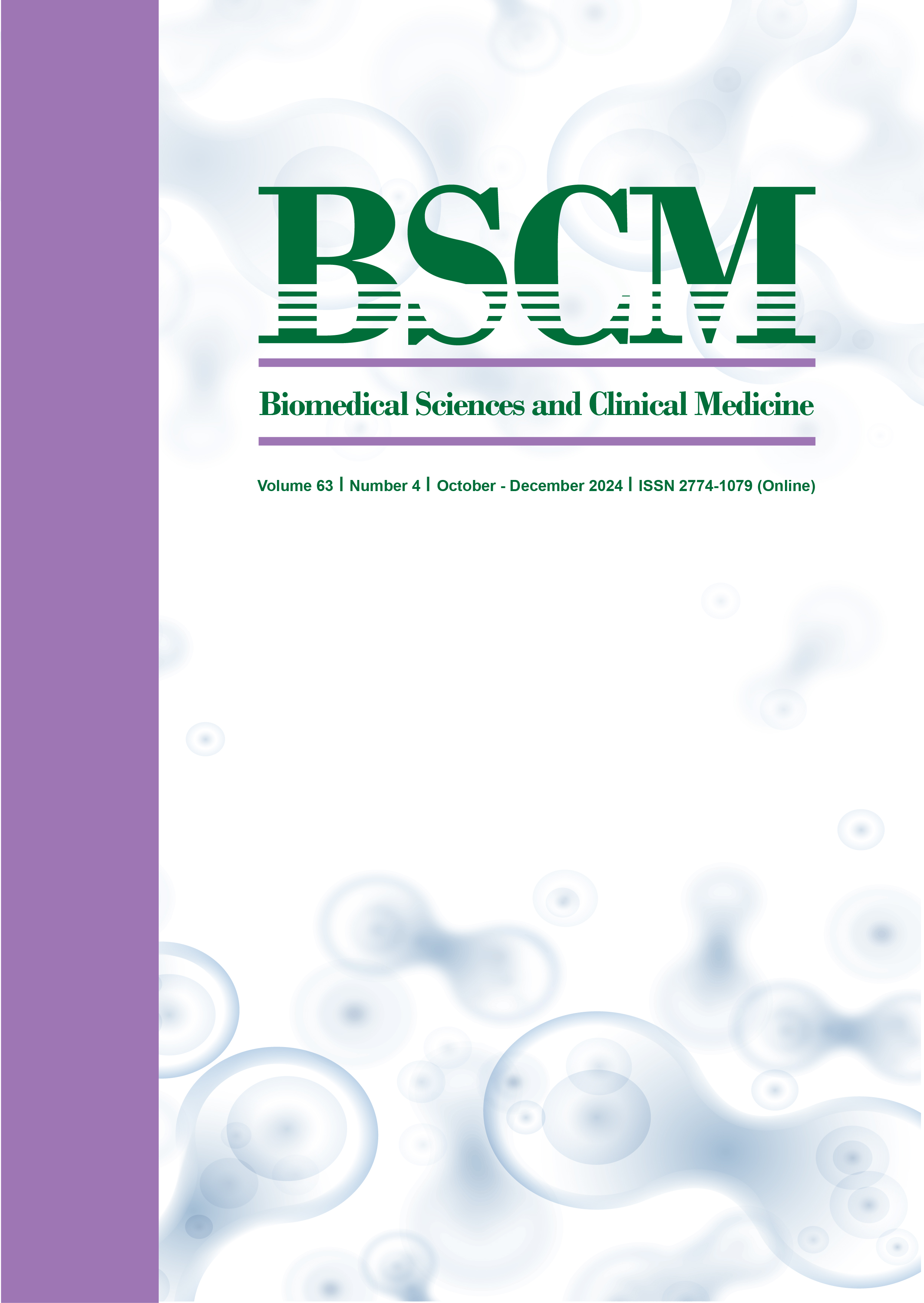Association Between use of a Single-Piston CPR Device in the Resuscitation Process and the Short-Term Survival of OHCA Patients
Main Article Content
Abstract
Objective There is still a lack of evidence regarding the efficacy of using a single point piston without suction cup mechanical cardiopulmonary resuscitation (CPR) device in the resuscitation of out of hospital cardiac arrest (OHCA) cases in a moving ambulance setting. The aim of this study is to evaluate and compare short term survival rate return of spontaneous circulation (ROSC) of emergency medical service (EMS) delivered to OHCA patients receiving single point piston without a suction cup mechanical CPR device and manual CPR.
Methods This case control study was conducted using data on OHCA patients between 1 January 2017 and 31 March 2020 using part of the Pan-Asian Resuscitation Outcomes Study (PAROS) data. Cases were classified as ROSC or no ROSC. Logistic regression analysis was used for the multivariable analysis of the primary objective.
Results A total of 206 cases were included in this study, 68 ROSC cases and 138 no ROSC cases. The multivariable analysis found no significant difference in the ROSC rate of EMS delivered OHCA patients who received only manual CPR and patients who received the mechanical CPR either in the EMS (OR: 0.49, 95% confidence interval [CI]: 0.13-1.78) or the emergency department (ED) (AOR: 16.05, 95% confidence interval [CI]: 0.18-1435.78).
Conclusions The use of the single point piston without suction cup CPR device in OHCA cases was not found to be inferior in terms of ROSC rate compared with manual CPR. Also, potential benefits in a prehospital setting could be provided by the device use, e.g., fewer staff required in the EMS. Use of the device should be considered in appropriate situations.
Article Details

This work is licensed under a Creative Commons Attribution 4.0 International License.
References
Callaway C, Soar J, Aibiki M, Böttiger B, Brooks S, Deakin C, et al. Part 4: Advanced Life Support: 2015 International Consensus on Cardiopulmonary Resuscitation and Emergency Cardiovascular Care Science With Treatment Recommendations. Circulation. 2015;132(Supplementary_1): S84-145.
Sugerman N, Edelson D, Leary M, Weidman E, Herzberg D, Vanden Hoek T, et al. Rescuer fatigue during actual in-hospital cardiopulmonary resuscitation with audiovisual feedback: a prospective multicenter study. Resuscitation. 2009;80:981-4.
Stiell I, Brown S, Nichol G, Cheskes S, Vaillancourt C, Callaway C, et al. What is the optimal chest compression depth during out-of-hospital cardiac arrest resuscitation of adult patients? Circulation. 2014;130: 1962-70.
Magliocca A, Olivari D, De Giorgio D, Zani D, Manfredi M, Boccardo A, et al. LUCAS versus manual chest compression during ambulance transport: A hemodynamic study in a porcine model of cardiac arrest. J Am Heart Assoc. 2019;8:e011189. PubMed PMID: 30590977
Szarpak L, Truszewski Z, Czyzewski L, Frass M, Robak O. CPR using the lifeline ARM mechanical chest compression device: a randomized, crossover, manikin trial. Am J Emerg Med. 2017;35:96-100.
Bonnes J, Brouwer M, Navarese E, Verhaert D, Verheugt F, Smeets J, et al. Manual cardiopulmonary resuscitation versus CPR including a mechanical chest compression device in out-of-hospital cardiac arrest: A comprehensive meta-analysis from randomized and observational studies. Ann Emerg Med. 2016;67: 349-360.
Wang P and Brooks S. Mechanical versus manual chest compressions for cardiac arrest. Cochrane Database Syst Rev. 2018;8:CD007260. PubMed PMID: 30125048
Fox J, Fiechter R, Gerstl P, Url A, Wagner H, Lüscher T, et al. Mechanical versus manual chest compression CPR under ground ambulance transport conditions. Acute Card Care. 2013;15:1-6.
Couper K, Quinn T, Lall R, Devrell A, Orriss B, Seers K, et al. Mechanical versus manual chest compressions in the treatment of in-hospital cardiac arrest patients in a non-shockable rhythm: a randomised controlled feasibility trial (COMPRESS-RCT). Scand J Trauma Resusc Emerg Med 2018;26:70. PubMed PMID: 30165909
Perkins G, Jacobs I, Nadkarni V, Berg R, Bhanji F, Biarent D, et al. Cardiac arrest and cardiopulmonary resuscitation outcome reports: update of the utstein resuscitation registry templates for out-of-hospital cardiac arrest: a statement for healthcare professionals from a task force of the International Liaison Committee on Resuscitation (American Heart Association, European Resuscitation Council, Australian and New Zealand Council on Resuscitation, Heart and Stroke Foundation of Canada, InterAmerican Heart Foundation, Resuscitation Council of Southern Africa, Resuscitation Council of Asia); and the American Heart Association Emergency Cardiovascular Care Committee and the Council on Cardiopulmonary, Critical Care, Perioperative and Resuscitation. Circulation. 2015;132:1286-300.
Gao C, Chen Y, Peng H, Chen Y, Zhuang Y and Zhou S. Clinical evaluation of the autopulse automated chest compression device for out-of-hospital cardiac arrest in the northern district of Shanghai, China. Arch Med Sci. 2016;12:563-570.
Truszewski Z, Szarpak L, Kurowski A, Evrin T, Madziała M and Czyzewski L. Mechanical chest compression with the LifeLine ARM device during simulated CPR. Am J Emerg Med. 2016;34:917. PubMed PMID: 26924321
Czapla M, Zielińska M, Kubica-Cielińska A, Diakowska D, Quinn T and Karniej P. Factors associated with return of spontaneous circulation after out-of-hospital cardiac arrest in Poland: a one-year retrospective study. BMC Cardiovasc Disord. 2020;20:288. PubMed PMID: 32532201
Navab E, Esmaeili M, Poorkhorshidi N, Salimi R, Khazaei A, Moghimbeigi A. Predictors of out of hospital cardiac arrest outcomes in pre-hospital settings; a retrospective cross-sectional study. Arch Acad Emerg Med. 2019;7:36. PubMed PMID: 31555766
Anantharaman V, Ng BL, Ang SH, Lee CY, Leong SH, Ong ME, et al. Prompt use of mechanical cardiopulmonary resuscitation in out-of-hospital cardiac arrest: the MECCA study report. Singapore Med J. 2017; 58:424-31.
Seewald S, Obermaier M, Lefering R, Bohn A, Georgieff M, Muth CM, et al. Application of mechanical cardiopulmonary resuscitation devices and their value in out-of-hospital cardiac arrest: A retrospective analysis of the German Resuscitation Registry. PLoS One. 2019;14:e0208113. PubMed PMID: 31555766


